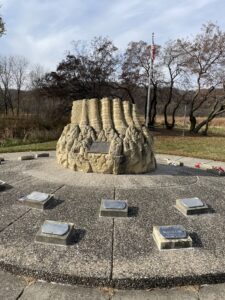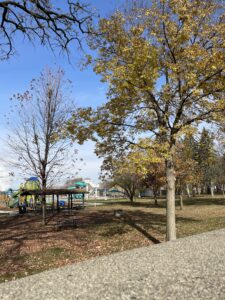Hikers and bikers can honor the service of all veterans any day of the year by visiting the Greater Mankato area’s fourteen memorial sites on the Trail for Heroes. This twelve-mile scenic route winds through the two historic city centers and beautiful natural landscapes as it leads visitors to monuments that commemorate the sacrifices of veterans from the 1800s to the present day. The route uses public roads and trails that are easily accessible on foot and bike. Parking is also available at most locations if you prefer to reach the sites by vehicle. Amenities along the way include parks with varieties of recreational opportunities, and businesses with shopping, dining and other services.
Veterans’ Memorial Place
 Mulberry and 2nd Street, Mankato
Mulberry and 2nd Street, Mankato
This memorial was dedicated on July 4, 2012 to honor both war and peacetime service to the country. The star shaped design symbolizes the five military branches, and the site serves as a gateway to the Veterans’ Memorial Bridge nearby. Unique features of the memorial are the brick pavers that can be donated by those who want to personally recognize a service member. The name, rank, branch and dates of service for each veteran are etched into the bricks, individually honoring hundreds on the site.
Tourtellotte Park
300 West Mabel Street, Mankato
This popular park and swimming pool is named for Connecticut-born lawyer, John E. Tourtellotte, who came to Mankato in 1858. When the Civil War began three years later, he enlisted in the 4th Minnesota Volunteer Infantry Regiment and gradually rose in rank to command the unit. Tourtellotte and his men are best known for their heroic actions in north Georgia during the famous March to the Sea in 1864 when the 2,000-man regiment defended a vital mountain pass against a Confederate force more than three times their size. After losing a third of his troops in the battle, the seriously wounded commander refused to leave his men and continued to lead the regiment from an ambulance.
Tourtellotte retired from the Army in 1885 and, although he lived in Washington, D.C. for most of his later years, he visited Mankato often and donated $8,000 to the city. The money was used to build a hospital near this site, and when it closed, the city created the park named in his honor in 1903. Tourtellotte died in 1891 and is buried in Arlington National Cemetery.
 Dakota Winter Warrior Memorial
Dakota Winter Warrior Memorial
101 North Riverfront Drive, Mankato
The “Winter Warrior” statue was inspired by the “Year of Reconciliation” proclaimed by Governor Rudy Perpich in 1987. It was a statewide attempt to foster healing and education between non-Dakota and Dakota people. The statue was unveiled on December 26, 1987 near the site of the 1862 hanging of 38 Dakota Indians.

Korean War Memorial
100 East Main Street, Mankato
The Korean War Memorial is located in Mankato’s City Center next to the Blue Earth County Library. Depicting a lone figure clad in a winter combat uniform, the monument honors all who served in Korea from 1950 to 1953 and includes the names of all Minnesotans who died in the war veteran are etched into the bricks, individually honoring hundreds on the site.
 Parque de la Reconciliación
Parque de la Reconciliación
100 North Riverfront Drive, Mankato
Reconciliation Park was dedicated on September 19, 1997. The park is the site of the largest mass execution in U.S. history where 38 Dakota Indians were hanged by the federal government. This was the result of trials following the U.S. Dakota Conflict of 1862. Tom Miller sculpted the buffalo from a 67-ton block of local Kasota limestone. The buffalo symbolizes the spiritual survival of the Dakota People and honors the Dakota heritage of this area. The park is a site to reflect, meditate and remember. “A reconciliation for all people.” Veterans are etched into the bricks, individually honoring hundreds on the site.
 Veterans’ Memorial Bridge
Veterans’ Memorial Bridge
200 Mulberry Street, Mankato
The Veteran’s Memorial Bridge is the third structure to cross the Minnesota River in the city center area, replacing two previous ones built in 1917 and 1879. Dedicated on Veteran’s Day in 1986, the bridge stands as a memorial to all the men and women of the Mankato and North Mankato area who have and do serve their nation in the armed forces of the United States of America.
World War II Memorial

Wheeler Park, North Mankato
Located on the site of a former brickyard, Wheeler Park is home to one of Minnesota’s most popular World War II memorials. A unique Kasota stone monument includes the “Ruptured Duck” insignia for Honorable Service in World War II. Military folklore holds that the golden eagle featured in the design looked more like a duck. An embroidered version of the insignia was authorized for wear on the uniforms of soon-to-be discharged service members, so it became common to say they “took off like a ruptured duck” when they left for home. Honorably discharged men and women also received gold lapel buttons with the same emblem for civilian wear, so the insignia became a nostalgic service symbol for America’s “Greatest Generation.”
The flags of all branches of the service also fly over the park’s southwest plaza on the corner of Grant Ave. and Center Street. Here, the North Mankato American Legion Post 518 honors a deceased veteran, POW or MIA of any war by flying his or her burial flag for a month to commemorate their service. On the first Saturday of every month, Taps is played as the flag is lowered, refolded and presented to the veteran’s family members. The ceremony concludes as the flag of the next Veteran of the Month is raised. If you miss the service, a biography of the current honoree is posted on the plaza for visitors to read.

Jacob Thompson Memorial Pier
Spring Lake Park, North Mankato
This 80-foot-long public fishing pier is dedicated to the memory of U.S. Army Staff Sergeant Jacob M. Thompson who was killed in action on his second tour of duty in Iraq in August 2007. A North Mankato native, SSG Thompson grew up near Spring Lake Park, where he often went fishing with his father. The popular park has been a favorite fishing site since its establishment in 1949. The addition of the new ADA-compliant pier in 2010 makes the lake accessible to all. Built of durable ironwood, the structure serves as a living memorial to the life and service of SSG Thompson.
 Centennial Park
Centennial Park
Belgrade Avenue and Lake Street, North Mankato
Centennial Park was dedicated in 1998 in celebration of the City of North Mankato’s 100th year. The park consists of a fountain, flags, benches and pavers which can be engraved for dedication to individuals or events. A Flag Day celebration is held here every year by Mankato Elks Lodge #225.
 Sibley Park World War I Monument
Sibley Park World War I Monument
900 Park Lane, Mankato
Created in 1887, the park was named in honor of Brigadier General Henry H. Sibley, early trader and commander of U.S. Army forces during the Dakota Conflict in 1862. Sibley camped on the mound as early as 1840 and had a log trading post located about where the Ott Cabin now stands northwest of the mound. The popular park has always been known for its zoo, beautiful gardens, ball fields and picnic areas. In 1926, a war memorial was constructed on the site with two German 105 mm howitzer field guns captured during World War I. The artillery pieces were donated for scrap during World War II. As a result, the war memorial they were once part of was forgotten for decades.
On Veterans Day 2011, a new heritage marker containing the 1926 commemorative plaque and a photo of the howitzers was placed on the site renewing the original intent to honor World War I veterans. (Brigadier General Henry H. Sibley, pictured in his army uniform in 1862, Engraving by J. C. Buttre. From the Minnesota Historical Society collections.)
Blue Earth and Nicollet Counties Vietnam Veterans’ Memorial

Stoltzman Road, Mankato
The Vietnam Veterans Memorial is located adjacent to the scenic wetlands, forests and bluffs of Rasmussen Woods. In December 1965, the Mankato City Council named the newly built “slough road” to honor U.S. Marine Corporal George L. Stoltzman who had been killed in action in Vietnam in November, becoming the first Mankato casualty in the war. Vietnam veterans later decided that the monument site should be located along the same road, and the City Council approved the present-day location in 1987. The memorial depicts a United States flag bursting from a rock. The names of those from Blue Earth and Nicollet Counties who died in the Vietnam War are engraved into metal plates resembling dog tags around the base of the memorial.

MSU Vietnam Memorial
Southeast corner of Memorial Library, Minnesota State University, Mankato
In 1983, the Vietnam War Memorial was dedicated by the Minnesota State University, Mankato Vets’ Club. The inscription, “For those who fought for it, freedom has a taste the protected will never know,” was submitted by John Domeier, a Vietnam veteran. The actual author is unknown. The memorial was designed by US Air Force veteran Mark Dragan, a Minnesota State University junior at the time.
Highland Park Civil War Site

950 Warren Street, Mankato
This popular park in the Highland neighborhood was well beyond Mankato’s settled streets in the 1860s. Located on a road that led out of town to the southeast, the site served as a recruiting ground and housed soldiers during the Civil War. In the 1920s, it was a tourist camp and had a small zoo.

Lincoln Park Civil War Monument
200 Lincoln Street, Mankato
In 1885, Mankato Civil War veterans proposed erecting a monument in memory of the Union soldiers from Blue Earth County. A triangle piece of land owned by W.H. Shepard was purchased for the purpose of erecting the monument and creating a park. In 1893, the Alexander Wilkin Post #19 G.A.R. dedicated the “Boy in Blue,” a bronze statue of a Civil War Union private soldier in a stone pool basin. It was replaced in 1935 by a red granite Civil War memorial marker. A Spanish-American War cannon was added to the park in 1900. In 1909, the cannon was loaded and fired by a group of kids. The blast broke windows on all sides of the park. The city donated the cannon to a scrap drive in 1943. The “Boy in Blue” monument was returned to the park in 2013 during the American Civil War Sesquicentennial.

Bonus Stop: Victory Highway Monuments
1398 S Victory Drive, Mankato
In 1948, area residents planted 1,170 trees along MN Highway 22 honoring World War I and World War II veterans from the Mankato area. The highway, known locally as “Victory Highway”, was scheduled for reconstruction starting in 2017, requiring the removal of approximately 600 Victory trees. Today, 5 new monuments stand tall along the Highway, signifying the US Army, Marines, Navy, Air Force, and Coast Guard.






